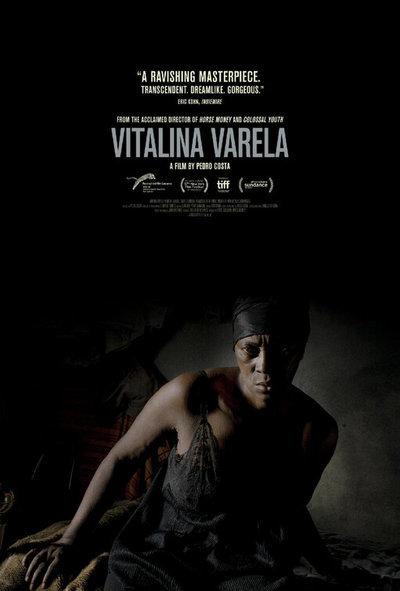
Film director Jean Luc Godardhad said “In the temple of cinema, there are images, light and reality. Sergei Parajanov was the master of that temple.”Parajanov, the late master filmmaker from Russia, underscored the importance of bright colours and realistic sound, while Pedro Costa’sVitalina Varela goes a step further, accentuating darkness, dark skin, and shadows with muted indirect lighting in a “colour” film, aided with natural sound. When you do see bright images in Vitalina Varela, as at the end of the film, it is not just real bright light and colours, it presents a metaphoric change in the film’s narrative structure.
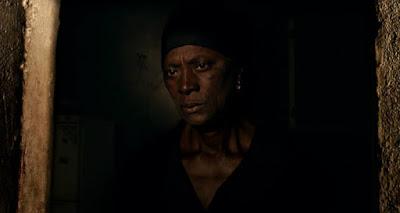
The award-winning actress plays herself in the film about herself
Vitalina Varela is distinctly different from the Oscar nominees of 2019 or well known commercial films with renowned actors. Vitalina Varela is an unusual film with a title that has the name of its lead actress. The film narrates the real story of its lead actress, a Cape Verdean immigrant arriving without papers in Portugal following her husband’s demise.(She acquired the formalpapers authorizing her stay in Portugal halfway into the production of this film, several years after her actual arrival.) Its director Pedro Costa, and his close-knit committed production team of cinematographer Leonardo Simoes, sound mixers (Joao Gazua and Hugo Leitao), production manager, and stock actors can be proud of their low-cost final product that offers higher aesthetic values than the multi-million dollar products from either Hollywood or Bollywood. It is definitely one of the remarkable films made in 2019, if not the decade, at least for audiences less addicted to conventional action and sex thatmakes a majority of contemporary films make money at the box office. While the film is made by a white (Caucasian) Portuguese crew,all the characters in Vitalina Varela are dark-skinned Africans from Cape Verde. Half of a film festivalaudience viewing Vitalina Varela (in which this critic was a spectator) walked out of the film screening halfway, while the other half stayed rooted in their seats right up to the end of the film and stood up to applaud the film, even though none of the filmmakers were present at the screening. (This critic recalls that in 1979, when an Andrei Tarkovsky film retrospective was screened in New Delhi, during an international film festival, some spectators who had paid for their tickets tore up their seats at the Archana theater where the films were screened in frustration as they could not comprehend or appreciate Tarkovsky's cinema. Today, ironically the same films, are likely to be treated with awe and respect.)
Ms Varela, the lead actress of Vitalina Varela, has little or no acting experience. She emotes and reconstructs with staggering dignity the world of her recent widowhood and love for her late husband, Joachim, who chose to live the demanding life of an immigrant in the Fontainhas sector of Lisbon, Portugal, for some 25 years, retaining for his memory Ms Varela’s wedding photograph, carefully preserved in a photo frame in his ill-lit, shanty dwelling. This award-winning performance of the actress is comparable to the very best in the world, thanks to Costa’s perseverance and extended committed interaction with her developing the film from scratch for several years prior to the shooting of the film.
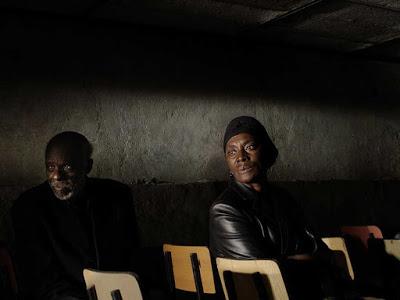
The priest (Ventura) and the widow (Vitalina Varela),
in the church without any other worshippers
Contemporary Russian maestro Aleksandr Sokurov made unforgettable, poetic films Mother and Son (1997) and Father and Son (2003). Had Sokurov made Vitalina Varela, he would possibly have titled it as “Wife and Husband.”
Vitalina Varela is a recounting of real events of Varela’s arrival in Portugal from Cape Verde island in the Atlantic, off the African continent (and a former Portuguese colonial territory), a few days after the death and burial of her husband Joachim, originally a bricklayer, more recently a person who survived by doing odd jobs. Like Sokurov’s elegiac Mother and Son, Costa’s Vitalina Varela is essentially a monologue of Vitalina seemingly speaking to her dead husband about her memories with him, comparing the stone house in Cape Verde they built together decades ago, with the tin shanty house in Lisbon. The Lisbon “palace” that Joachim promised her decades ago that she occupies following Joachim’s passing is a shanty house with a leaking roof.
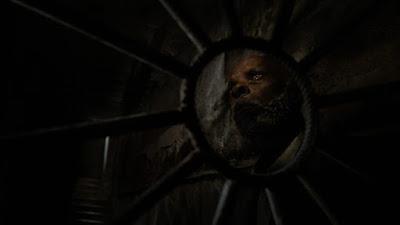
The priest (ventura) metaphorically "carrying the cross
on his shoulders": director Costa and
cinematographer Simoes at their best
The only real dialogues in the film are those between the priest—a real character, a priest of a derelict church in Lisbon, reeling under his guilt of turning away a busload of Cape Verde Christians, who had approached him while he was a priest in Cape Verde to baptise a child without proper papers. The busload of Christians he turned away were killed in a road accident a short while later and the priest carries that cross of his action of refusing to baptise the child to this day. Costa’s film brings together two individuals from Cape Verde, both suffering from recent tragedies, both religious individuals, both alone in a new country where even God seems to have forsaken them.One line spoken duringthe interaction between the two is evocative: “I had the cross of Christ on my shoulders. I couldn’t move. When I fell, I was free.” A fascinating religious commentary, indeed, in a film that did not have a prior written script.
In Vitalina Varela, the spoken words are less important than the visuals.A striking point in the film is the arrival of Vitalina in Lisbon.A plane arrives on the tarmac of the airport and the sole V.I.P. to emerge from it is Vitalina. The “V.I.P.’s” feet are shown as she climbs down the steps from the plane. (A cineaste would recallthe Japanese director Mikio Naruse’s classic 1960 film When a Woman Ascends the Stairs and the inverse relationship of the feetshown in Vitalina Varela descending from the plane in this sequence.) They are wet. You would expect lights in an airport—but the scene is dark, the person is dark skinned, and wearing clothes appropriate for mourning. The “V.I.P.s “ reception committee are made up of fellow Cape Verdean immigrants working as cleaners at the airport, one of whom honestly tells her “Vitalina, my condolences. You are too late. Your husband’s funeral was 3 days ago. There is nothing for you in Portugal. His house is not yours. Go back to Cape Verde.” Some reception for a widow!
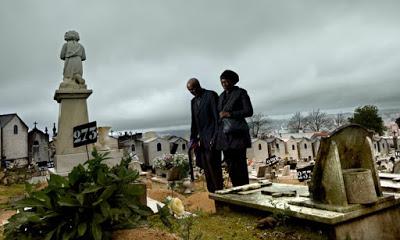
A rare bright shot in the film is at the grave of Joachim
Just as Parajanov emphasized light in his films, Cost and his cinematographer Leonardo Simoes emphasizes the importance of light by erasing it and using it sparingly to accentuate its importance. This is a colour film that appears to show more black (or lack of light) in most of the sequences with indirect lighting often behind the actors to give a silhouette. It fits with its the subject matter—it is a film dealing with death, sorrow, loneliness, African immigrants struggling to survive in Europe, lack of money and love. Even in daytime, much of the scenes are shot in shadows. Each of these dreamlike shots is aesthetically crafted in austere surroundings and a pleasure to perceive. There are unforgettable sequences of tired immigrant workers returning home at night, hardly speaking to each other, in dimly lit streets close to cemeteries. You are reminded of sparse visual stage settings crafted by playwrights Samuel Beckett and Eugene Ionesco for their works. And natural sounds and bleak visuals, "speak' as much as humans do in this film.
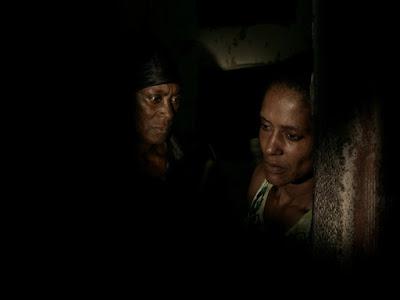
Vitalina interacts with another woman,
who has burdens of her own
Ultimately Vitalina Varela is a film about a woman and the spoken words are bound to reflect a feminine viewpoint. In a response to the priest who has kind words for her dead husband, Vitalina responds with criticism that is considerably true ”Men favour men. When you see a woman’s face in the coffin, you can’t imagine her suffering.” Suffice it to say that the film captures all this and more.
The citation for the film’s Silver Hugo award at the Chicago film festival sums it all: “..for a ravishing and masterful vision between horror and melodrama, spirituality and desperation that blew the jury all away."
P.S. Vitalina Varela is one of the author’s top 20 films of 2019. Much of the dialogues quoted above are from memory of a single viewing and are approximations. The film won the Golden Leopard award for the best film and the Best Actress award at the Locarno Film Festival; the Silver Hugo Award for the best feature film at the Chicago International Film Festival; the Best Director, Best Actor and Best Cinematography Awards at the Mar del Plata Film Festival; the Grand Prize of the Jury at the La Roche-sur-Yon International Film Festival (France); and the Best Cinematography Award at the Gijón Festival International Film Festival (Spain). The Brazilian film, The Fever, mentioned in the review, is also one of the author’s top 20 films of 2019.

